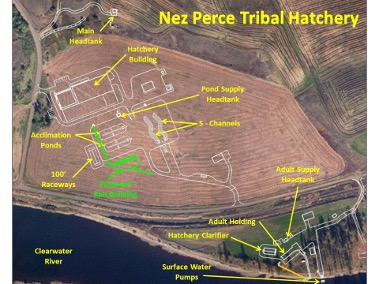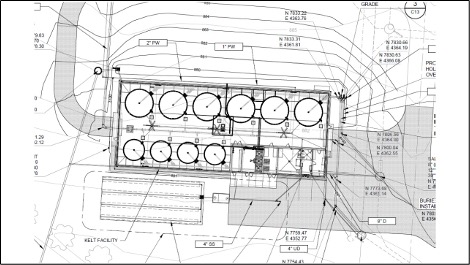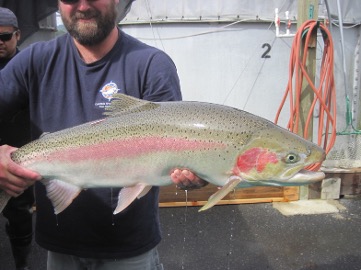NPT Begins Construction of Kelt Reconditioning Facility in Idaho
Lapwai, Idaho – After 16 years of planning, preparation, and advocacy, the Nez Perce Tribe is ready to start construction of a Kelt Reconditioning Facility at the Nez Perce Tribal Hatchery in Cherrylane, Idaho to aid steelhead spawn more than once. Snake River wild steelhead populations have declined significantly over the past several years, and this facility will be the first hatchery project in the basin aimed specifically at recovering this threatened run.
The Nez Perce Tribe, in partnership with the Yakama Nation, Columbia River Inter-Tribal Fish Commission, and the University of Idaho, developed the Kelt Reconditioning Project to improve steelhead kelt survival. The project, operated in coordination with the U.S. Army Corps of Engineers, collects downstream migrating kelts at Lower Granite, Little Goose, and Lower Monumental dams on the Snake River.
Only about two percent of the Columbia Basin steelhead population successfully spawn twice. Thousands try to migrate to the ocean after spawning but die before reaching the ocean due to limitations on downstream adult fish passage at hydroelectric dams. As a result, fewer are found in the Snake and upper Columbia rivers than elsewhere in the basin.
This project aims to assist steelhead in becoming repeat spawners, a trait that has become increasingly rare due to mounting challenges such as sea lions, invasive predators, dams, and fishers. Rising temperatures have added to these challenges, making this project crucial for the survival of these remarkable fish. By collecting and reconditioning kelts, the tribal programs are helping wild steelhead spawners that would most likely have died.
“Most people know that anadromous fish, such as as salmon, die shortly after they spawn,” said Dave Johnson, Director of the Nez Perce Department of Fisheries Resources Management. “Most steelhead in the Columbia Basin only spawn once as well. But when conditions are right, steelhead can spawn a second time. The goal of the Kelt Reconditioning Project is to provide those right conditions to as many steelhead as possible. Because the wild runs of Snake Basin B-run steelhead are so low, the use of kelts has become an emergency action to put some fish on the spawning grounds to spawn a second time.”
The Columbia River treaty fishing tribes remain the only fisheries managers conducting steelhead kelt reconditioning research in the Columbia Basin. These programs have been successful in identifying reconditioning strategies and methods that work best. Kelt reconditioning has proven effective in improving wild steelhead survival by avoiding multiple dam passages, predation, and unpredictable ocean conditions.
“The Nez Perce Tribe looks forward to operating a facility dedicated to kelt reconditioning and recovering this culturally important species,” said Shannon F. Wheeler, Chairman of the Nez Perce Tribal Executive Committee.
The new facility, funded by the Bonneville Power Administration, will be constructed by Syblon Reid General Engineering with engineering support from Kleinschmidt Associates. Once completed in the spring of 2026, the facility will be capable of long-term reconditioning of up to 750 steelhead kelts on a budget of just under $1 million annually while employing four full-time employees.
The addition to the Nez Perce Tribal Hatchery was first proposed in 2008. In 2016, the Northwest Power and Conservation Council (NPCC) approved the project’s Master Plan. The NPCC’s Independent Science Review Panel highlighted kelt reconditioning as a successful strategy in their 2022 review, stating, “The project provides an excellent example of developing a relatively uncertain approach into a viable management alternative to enhance spawner abundance in natural steelhead populations.” The National Marine Fisheries Service recognized the Kelt Reconditioning Project as the sole hatchery action in the basin directly enhancing wild steelhead abundance.
Once the new facility is completed, the Nez Perce Department of Fisheries Resource Management will collect outmigrating kelts after spawning and transport them to the Nez Perce Tribal Hatchery, where they will be held in optimal conditions and fed to increase their survival chances and rebuild the energy reserves required for repeat spawning. After overwintering in the hatchery, the kelts will be released back into the Snake River, coinciding with the river’s main steelhead run to ensure the reconditioned kelts have plenty of spawning potential. A reconditioned steelhead kelt can produce 9,000 eggs compared to a first-time spawner’s average of 6,000 eggs, so increasing their survival has the potential to significantly enhance ESA-listed steelhead populations. Past releasees of kelts have accounted for as much as 38% of the entire B -run steelhead population spawning in the Snake River Basin.
In 2017, only 263 wild B-run steelhead were estimated to have crossed Lower Granite Dam (the preseason estimate was 500). Kelt reconditioning at these levels can provide a substantial increase on the number of natural spawners. In the fall of 2017, the kelt project at Dworshak released 100 reconditioned wild steelhead to spawn naturally, increasing the abundance of wild B-run steelhead by 38%. Since 2017, releases of reconditioned kelts have increased the number of wild B-run steelhead available to spawn naturally in the Snake Basin by 2% to 10%.
“This project demonstrates the Nez Perce Tribe’s commitment to the recovery of steelhead and other culturally important life sources for the benefit of the ecosystem, our traditional use of these First Foods, and for all residents who enjoy healthy and sustainable fish runs,” said Chairman Wheeler.
 Figure 1. Location of the kelt facility on the campus of the Nez Perce Tribal Hatchery.
Figure 1. Location of the kelt facility on the campus of the Nez Perce Tribal Hatchery.
 Figure 2. Kelt Reconditioning Facility’s tank and room layout.
Figure 2. Kelt Reconditioning Facility’s tank and room layout.
 Figure 3. Reconditioned steelhead kelt just prior to release.
Figure 3. Reconditioned steelhead kelt just prior to release.
